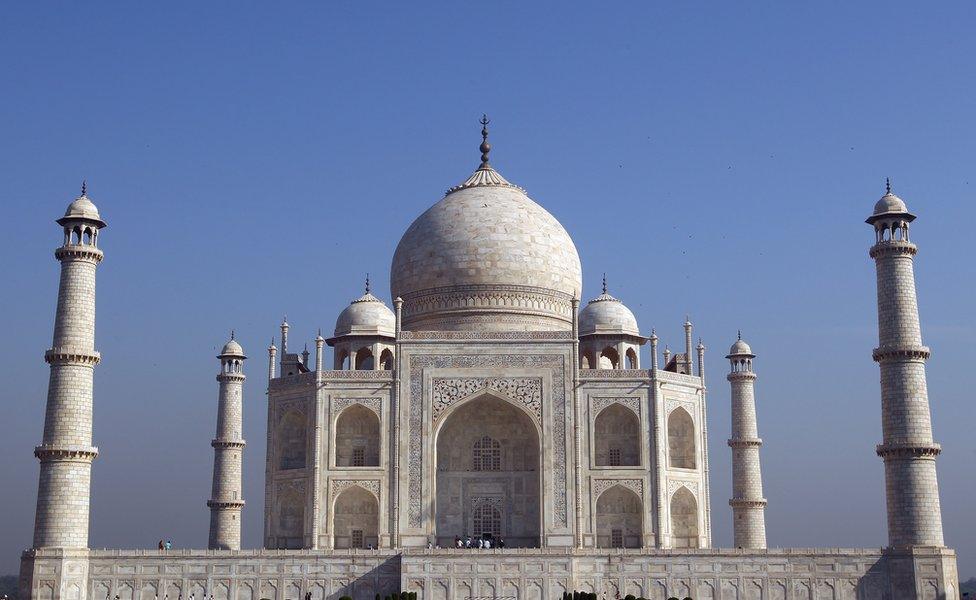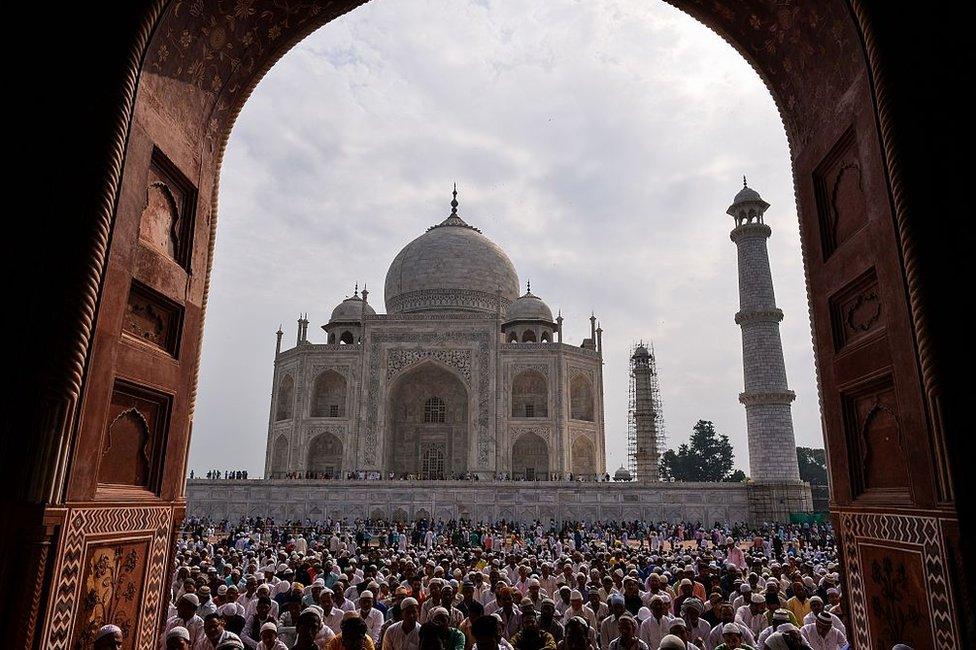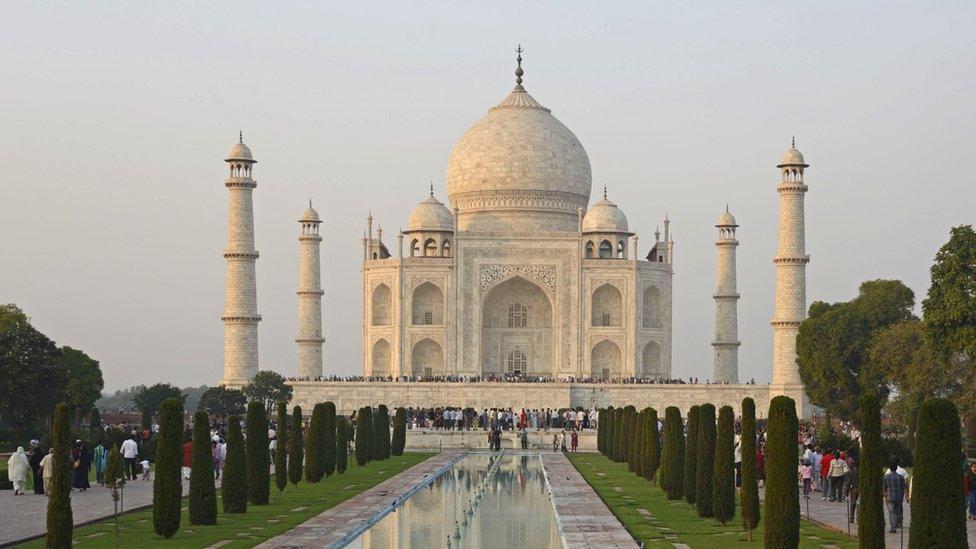Reality Check: Whose Taj Mahal is it anyway?
- Published

The Taj Mahal is located in the northern Indian city of Agra
The claim: An Indian MP and some right-wing groups claim that the iconic Taj Mahal is a Hindu temple.
Vinay Katiyar from the ruling Bharatiya Janata Party (BJP) recently asked the government to change the name and identity of the monument and acknowledge that a Hindu ruler built it.
His statement has been widely reported in the media, prompting many right-wing groups to support him.
Reality Check verdict: There is no convincing evidence to back the claim. Instead the vast majority of historians and the Indian government agree that the mausoleum is a fine example of Indo-Islamic architecture.
Who built it?
India's official recorded history says that Mughal (or Mogul) ruler Shah Jahan built the Taj Mahal in memory of his queen, Mumtaj Mahal.
The Mughals, who originally came from Central Asia, ruled most of what is now India and Pakistan in the 16th and 17th Centuries.
The Mughal empire consolidated Islam in South Asia, and spread Muslim arts and culture as well as the faith through the region.
And the Taj Mahal epitomises their love for fine craftsmanship.
The Archaeological Survey of India, external, the custodian of the country's monuments, describes the Taj Mahal as "the pinnacle of Mughal architecture".
The government's official Taj Mahal website also says "the period of Mughal architecture best exemplifies the maturity of a style that had synthesised Islamic architecture with its indigenous counterparts".
"By the time the Mughals built the Taj, though proud of their Persian and Timurid roots, they had come to see themselves as Indian," it adds.

The Taj Mahal attracts millions of tourists every year
Historian Rana Safvi told the BBC that "there is no question" of revisiting the history of the Taj Mahal, and that there is no evidence a temple ever existed on the site.
"There was a haveli [mansion] owned by Hindu ruler Jai Singh which existed before the Taj was built there.
"Shah Jahan officially bought the haveli from him. An official farman [order] was issued about this and it still exists. The farman also shows that the Mughals were very particular about recording their deeds and history," she said.
Ms Safvi says a book titled Taj Mahal: The Illumined Tomb by WE Begley and ZA Desaihas compiled an anthology of these documents.
"From such books I realised how well-documented the building of the mausoleum was. I use these translations to present my arguments that the Taj Mahal was built on the land where Raja Jai Singh had a mansion and that there is no mention of any religious building on that land," she said.
Another noted historian, Harbans Mukhia, agrees with Ms Safvi.
"Recorded history proves beyond any doubt that the Taj Mahal was built by Shah Jahan in memory of his queen," he said.
School text books and various government websites also describe the monument as an example of Indo-Islamic architecture.
The temple theory
So where does this temple theory come from?
Mr Katiyar is not the first person who has demanded that the history of the Taj Mahal should be changed.
The late right-wing historian PN Oak called the monument Tejo Mahal in his 1989 book titled Taj Mahal: The True Story, external.
He argued in the book that the monument was originally a Hindu temple and palace built by a Rajput ruler.
Mr Oak believed that Emperor Shah Jahan seized the structure after a battle, and later renamed it the Taj Mahal.

The government conducts regular restoration work on the Taj Mahal
Writer Sacchidananda Shevde, who worked closely with Mr Oak, told BBC Marathi that the government should appoint a team of experts to "uncover the truth".
"Taj Mahal is not a piece of Muslim architecture. It's original Hindu architecture," he said.
But the government's official Taj Mahal website, external says the monument represents "a style that combines elements from Persian, Indian, and Islamic architectural styles".
The architecture question
Both Mr Katiyar and Mr Shevde argue that the Taj Mahal comprises a number of Hindu architecture symbols.
"There is a crescent moon on the pinnacle of the Taj. In Islamic culture, the moon is tilted, this crescent moon is not tilted, it's related to the Shaivaite [Followers of Hindu god Shiva] culture," Mr Shevde says.
"There is also a kalash [pitcher] on the pinnacle, there are mango leaves and inverted coconut in it. These are all Hindu symbols. Flowers and animals are prohibited in Islamic culture, yet they are used in Taj's construction," he added.
Mr Mukhia rejects these claims.
"Architecture always evolves and imbibes influences from many cultures. Mughal architecture is no different. The kalash is an important symbol for Hindus, but you also see it in Mughal monuments, including the Taj Mahal. Leaves and flowers have also been depicted in many Mughal buildings," he told the BBC.

The government conducts regular restoration work on the Taj Mahal
Why now?
For decades, the Taj Mahal has been used in official tourism campaigns to attract travellers from all over the world. The story of Shah Jahan and Mumtaj Mahal has been used by poets and writers to describe love.
So what does Mr Katiyar stand to gain by his claims?
His comment coincides with the rise of Hindu nationalism in India. Several BJP politicians have given provocative statements about restoring "Hindu pride" since the BJP came to power in 2014.
Mr Katiyar's latest statement also appears to be targeted at the people who believe in Hindu nationalism.
Such statements also help politicians deflect people's attention from real issues like job creation and the health of the economy.
Though the government has not endorsed his views, right-wing groups are more than happy to follow his lead.
One such group recently demanded, external that they should be allowed to offer Hindu prayers at the Taj Mahal.



- Published16 October 2017

- Published3 October 2017

- Published1 December 2015
